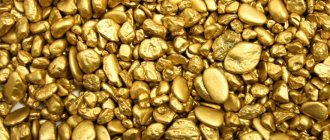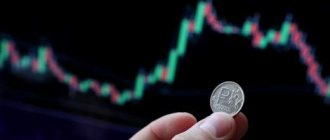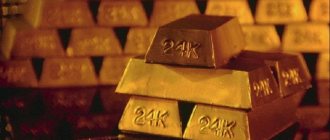►
watch video
►
read gold educational program
►
gold price forecast
We hear the word “quote” no less often than the word “price”. What the price means is known to everyone, but it’s worth understanding the quotes in more detail. In France they are called Cote, in England - Financial quote. Both indicate the price level acceptable for a buyer to buy and for a seller to sell. Quotes
(gold, for example) are rapidly changing exchange prices, which for convenience are often visualized in the form of graphs.
Once or several times a day, a special commission fixes or quotes prices on stock and commodity exchanges. The meaning of the verb “quote” follows from the word “coter” in French, meaning to mark (number).
Sources of quotes
Along with the era of the “gold standard,” gone are the days when gold consistently had the same value. Today's gold market dynamics are cyclical. A long recession is always followed by a period of growth. World political and economic events inevitably affect the precious metals market. The current rise in prices is a consequence of the global economic crisis, geopolitical tensions and trade conflicts.
Wanting to save their earned funds during the “turmoil” before they become just paper or meaningless numbers in a bank account, many seek to invest their savings in assets that are reliable and liquid. In this sense, humanity simply does not know anything more suitable than gold.
Potential investors will show keen interest not only in today's gold quotes, but also in tomorrow's possible exchange rate, as well as in price dynamics for the long term.
Among the trusted sources displaying the price of the yellow metal are the following:
- Metal Exchange in London;
- New York Commodity Exchange;
- Central Bank of the Russian Federation;
- Russian Sberbank;
- Yandex search engine.
London Metal Exchange (LME)
This is the largest platform in the world where non-ferrous and precious metals are traded. Over the century of the exchange's existence, the trading system has remained unchanged. Only the use of conference calls has been added. There are 6 main items traded here: lead, aluminum, copper, nickel, zinc and tin. Quotes are generated for rare earth metals and elements of strategic importance, such as vanadium, cobalt, selenium, cadmium, silicon and chromium. We also install fixings for precious metals: platinum, gold and silver.
The “London fixing” of the price of gold is formed by five main exchange players. Since 1919, two trading sessions have been held every day - at 10.00 GMT (13.30 Moscow time) and at 15.00 GMT (18.00 Moscow time). In most countries around the world, the price of gold is set on the basis of this fixing.
Commodity Exchange in New York
This futures company merged with the COMEX exchange in 1994. It is also included in the Chicago Board of Trade. Currently, its activities are carried out by two of its divisions - COMEX and NYMEX. The first of them deals with gold. Price is measured in US dollars per ounce.
The average person will only be interested in the quotes generated on these two largest trading platforms as food for thought.
The purchase and sale of precious metals in Russia is carried out at a price determined by the country's leading banking organizations, guided by the discount price of the Central Bank of the Russian Federation.
By the way.
A troy ounce corresponds to the weight of metal 31.1034807 in grams. With mathematical rounding, we get 31.103 grams. This measure was used back in Ancient Rome. Then a heavy copper coin weighing 1 pound was divided into 12 parts - ounces. Later, the “ounce of avoir du pois” (from the French avoir du pois) appeared, which was already equal to 1/16 of a pound. But a troy ounce continued to equal 1/12 of a pound. The definition of “Troy” comes from the name of the city of Troyes in France, where fairs were held in the Middle Ages. Traders from all over the world came here in the 13th century, and the standards adopted here enjoyed unquestioned authority.
Central Bank of the Russian Federation
In Russia, it is the Central Bank that sets discount prices for gold and other precious metals. It also provides the latest data on interbank lending conditions, exchange rates and refinancing rates. The unit of measurement for the value of gold here is rubles per 1 gram. The Central Bank sets prices daily based on the dollar rate, London fixing and information from the world's leading trading platforms. The cost of gold per 1 gram also takes into account the costs of transportation, customs clearance, etc. The validity period of each announced price is one day.
What is fixing, refined metals and why are prices called discount prices?
If the cost of materials is variable, then accountants and banks apply so-called accounting prices to them. The discount price of the precious metal is valid for a calendar day from the moment of its announcement until new values are formed.
Refined precious metals
This is the name of a precious metal (gold, platinum, palladium and some others) that has gone through all stages of processing from mining, enrichment and smelting of ore or processing of secondary materials and concentrates to the final product. There is a regulatory framework regulating the varieties, labeling and composition of refined metals. Thus, a gold nugget of considerable value is not considered refined. To do this, it must turn into a measured ingot, on which the sample and weight are indicated.
Sberbank of Russia
You can view gold quotes online on the Sberbank Internet resource. It shows the variability of dynamics over the past few years, and also contains an archive of price fluctuations.
Being the largest Russian participant in the gold market, Sberbank maintains branches in almost every locality of the country. At the same time, this financial organization is ready to offer various ways of investing in precious metals:
- Investments in gold and silver coins.
- Ingots of precious metals.
- Opening a compulsory medical insurance (an impersonal metal account).
Since the quotes (discount prices) determined by the Central Bank of the Russian Federation are advisory in nature, the price level in the Russian Sberbank may differ from them. Here, the price of gold is formed taking into account the internal market demand for precious metals in the country, the exchange rate of the ruble against the US dollar, discount prices of the Central Bank and data from international trading platforms that deal with gold.
It is worth remembering that Sberbank of Russia is a branched and structured organization with many branches that independently set their prices. Therefore, one gram of gold somewhere in the Far East can differ significantly in value from the same one gram in Moscow.
The level of spread at bank branches may also vary. This refers to the difference between the optimal acquisition cost and the selling price at the same point in time. In various branches of Sberbank, the spread value fluctuates in the range of 7-15% of the metal price.
What is the spread in private companies that sell investment and commemorative coins?
When compared to commercial banking institutions, our company as a coin dealer, and some other similar private companies, tend to offer lower spreads on the purchase and sale of coins.
Yandex
One of the most convenient tools for monitoring the cost of securities and raw materials, stock quotes and exchange rates is offered by the domestic search engine Yandex. Sometimes there is not enough time to visit special Internet resources to get acquainted with current gold prices. The rhythm of modern life simply does not leave us with it. But, since work and entertainment today are, in one way or another, connected to the Internet, accessing Yandex will not be difficult. And here there is a whole section related to quotes, where you can observe the annual, quarterly, monthly or weekly variability of the price of gold. There is also archival data for the time period 1996-2019.
Union of Gold Miners: Russia reduced gold output over nine months by 0.7%, to 268 tons
MOSCOW, November 18 – PRIME. Russian enterprises in January-September 2021, according to preliminary data, produced 268 tons of gold, mined and obtained as a result of associated production, including the processing of scrap and waste, as well as in concentrates - this is approximately 0.7% less than in the same period a year earlier, said Sergei Kashuba, Chairman of the Union of Gold Miners of Russia, speaking at the Russian Precious Metals Market Bullion-2021 forum.
Gold correctively declines in price after rising the day before
“Total primary (mineral) gold production for the first nine months of 2021 decreased by 1.7% to 243 tons,” he added. “Total primary (mineral) gold production for the first nine months of 2021 decreased by 1.7%, up to 243 tons,” he added.
According to a preliminary estimate by the Union of Gold Miners, gold production for nine months amounted to 219 tons (+0.3%), associated production - 13 tons (+2.6%), secondary (scrap and waste) - 25 tons (+10.2% ), gold in concentrates - 11 tons (-31.8%).
The Union of Gold Miners confirmed its forecast for 2021 for total gold production in the Russian Federation at 366 tons. Including the production of primary gold will increase by approximately 1% - to 336 tons.
As the Union of Gold Miners reported, in Russia in 2021 the total gold production amounted to 362.7 tons of gold, 1% less than in 2021. Including the production of minerals extracted by subsoil users increased by 1.6% - to 291.44 tons, with the associated production of non-ferrous metals 19.04 tons were obtained (an increase of 5.0%), the production of gold in concentrates for the year decreased by 9.08% - up to 20.6 tons. Another 31.61 tons of gold were obtained after processing scrap and waste (-17.87%).
The Union of Gold Miners of Russia is a professional industry association created in April 1995. Among the members of the union are enterprises for the extraction of precious metals and precious stones, refineries, commercial banks, engineering and consulting companies.
GOLD IN RESERVES
The Union of Gold Miners of Russia proposes to the Central Bank of the Russian Federation to resume purchases of gold and increase the share of the precious metal in reserves to 25%.
“As of October 1, the share of gold in gold and foreign currency reserves was 21% - $128.7 billion in monetary terms, and in physical terms 2,298 tons of gold... The Union of Gold Miners proposes that the Central Bank return to purchasing gold on the domestic market and increase the share of gold in gold and foreign currency reserves to at least 25 %. This will require 591 tons of gold. We believe that if the Central Bank actively returns to purchases, then over the next two years it can easily change this proportion,” noted the head of the union.
He explained that until recently the Bank of Russia was the main player in the market. But in recent years, the share of its purchases has been steadily declining: from 331.4 tons in 2021 to 29 tons in 2021. According to his estimates, in 2021 the Bank of Russia will purchase 30 tons of gold.
“The export of refined gold is completely correlated with the Central Bank’s purchases: the more the Central Bank bought, the less we exported. The Central Bank stopped purchasing on April 1 last year, and as a result, we sent 307 tons of gold abroad,” states Kashuba. In 2021, he said, refined gold exports will account for 300 tons.
In general, the head of the union believes, the demand for gold on the Russian banking market in 2021 will be 362 tons (-1%) with a projected production level of 366 tons. According to calculations by the Union of Gold Miners, the jewelry industry this year will reduce purchases by 31%, to 20 tons, due to the decline in consumer activity during the pandemic.
Russian realities
The announcement of gold quotations by the Central Bank of the Russian Federation is carried out every day, exactly at 14:30 Moscow time. The data is published on the pages of the official Internet resource of the Central Bank and is duplicated by all federal information agencies. These set prices are measured in rubles and include the costs of transporting the precious metal, clearing customs and other things.
The Central Bank is not obliged to purchase or sell gold according to the generated quotes, so they are a kind of convention. Other banks take them as a starting point and set their own prices. Thus, Sberbank in its quotes takes into account the current Russian demand for precious metals, the inflation rate and data from leading international exchanges.
To convert the price of gold from dollars per troy ounce to dollars per gram of 999.9 fineness, you need to divide the value in the morning AM at the beginning of trading or in the evening PM by 31.1035. Formula XXX,XX/31.1035=. To convert London fixings to rubles per gram of 585 sample, you need to divide the value in the morning AM at the beginning of trading or in the evening PM by 31.1035, then multiply by the dollar exchange rate according to the Central Bank of the Russian Federation, then multiply by 585 and divide by 999.9. Formula XXX,XX/31.1035*rate$*585/999.9=. XXX.XX is the price per troy ounce of gold.
London fixing in dollars per ounce of gold, silver, platinum, palladium
The London fixing is a snapshot of the interbank gold market, taken twice daily at 10:30 and 15:00 GMT. The fixing participants are five London banks - Rothschild, Standard Chartered Bank, Republic National Bank, Deutsche Bank and Midland Bank. It is held on the premises of the Rothschild bank. What happens in this case is reminiscent of an auction. A representative of the Rothschild bank announces the initial price, which, as a rule, represents the average price of the interbank market at that moment. And four bidders place their orders by raising a small English flag. As long as at least one flag in the hall is in the raised position, the price is not fixed, interests are being clarified. Typically, the fixing procedure takes from 5 to 15 minutes, but there are times when trading lasts more than two hours (this often happens during evening fixing). The participants have a gentleman's agreement that from the moment the price is fixed, all settlements between them are carried out at the fixing price plus 15 cents. Different prices are set for external clients. When they buy gold from a fixing participant, the fixing price is plus 25 cents, and when they sell it, the fixing price is plus 5 cents.
On 20 March 2015, benchmark prices for gold bullion in London began to be determined through the ICE electronic auction. The new system replaced the historical gold fixing, which had been in effect since 1919. The electronic process replaced the gold fixing system, which had operated without significant changes since 1919. The new auction system is not very different from the previous gold fixing in its methodology. Six banks are participating in the auction, through which the target prices of the day are now revealed - Barclays, HSBC, Societe Generale, Scotiabank, Goldman Sachs, UBS. All of them, with the exception of UBS and Goldman Sachs, were previously engaged in gold fixing. ICE expects to increase the number of accredited participants. Now for this you need to be a member of the London Bullion Market Association (LBMA)
LBMA was created in 1987. It includes banks, traders, and mining companies that deal with gold and silver. As of March 2015, the association had 76 full members (Members) and 69 associates (Associates, they have fewer rights). The LBMA sees its main task in the accounting and valuation of gold and silver bars. Only LBMA-accredited bullion is offered for auction in London. Their list is called Good Delivery List.
The modern gold benchmark is called LBMA Gold Price. It will be determined during the electronic auction. Prices will be set during 45-second trading twice a day - at 10:30 and 15:00 London time (14:30 and 19:00 Moscow time). The electronic platform is provided by the independent provider ICE Benchmark Administration. The LBMA will retain intellectual property rights. ICE was selected by the LBMA to host the Fall 2014 sessions. As the Financial Times explains, trading occurs as follows: anonymous orders from six banks for the purchase and sale of precious metals are published in real time. The system takes into account the difference between supply and demand and adjusts the price of gold until equilibrium is reached. It is defined as the difference between supply and demand within 20 thousand troy ounces. The sessions will be overseen by an advisory board consisting of two representatives from the gold mining industry (AngloGold Ashanti and Denver Gold Corp) and three representatives from the LBMA. Regulation will be carried out by the UK Financial Conduct Authority (FCA). The LBMA Gold Price benchmark will be used by gold mining and jewelry companies, central banks and financial institutions that trade in securities tied to the price of gold. For example, the Bank of Russia determines gold prices based on the London fixing values. The cost of the precious metal is converted into rubles at the official US dollar to ruble exchange rate, effective the next day after the accounting trading for gold. The London benchmark exists in parallel with gold futures trading on the NYMEX and Shanghai Gold Exchange. Traders correlate gold fix and futures prices, so they mutually influence each other. Gold Market in Figures from the World Gold Council A troy ounce, the industry unit of measurement for gold, contains 31,103. In 2014, demand for gold for bullion production was $32.89 billion, or 807.8 tons. In 2014, demand for gold by the jewelry industry amounted to $87.659 billion, or 2.1 thousand tons. In 2014, central banks purchased 477.2 tons of gold for $19.4 billion. At the end of 2013, Bloomberg estimated the volume of the global gold market at $20 trillion. At the end of last year, the association of global gold mining companies World Gold Council estimated the demand for investment gold at $36.83 billion. In total, according to the organization, global demand for gold in 2014 reached $159.7 billion. More details on RBC: https:// top.rbc.ru/finances/03/21/2015/550c2e309a794736c6f96e57 New York, real-time precious metals quotes in dollars per troy ounce
Prices for precious metals: gold, silver, platinum Central Bank of the Russian Federation and NYMEX (COMEX)
Gold rate of the Central Bank of the Russian Federation
Exchange rates of the Central Bank of the Russian Federation
How to apply gold buy and sell quotes?
If you need to buy or sell metallic gold or open a compulsory medical insurance, then first it is advisable to at least get a little insight into today’s quotes from Russian banks operating precious metals. The leading one among them is Sberbank of Russia. Visit its official website and get the necessary data about the price of gold. There are a number of other Internet resources that publish online forecasts of price dynamics and quotes for precious metals.
By the way.
On our website it is possible to track quotes for gold, silver, platinum, as well as exchange rates, literally in real time. Also in the catalog of coins next to the price you can see such an indicator as the premium to the exchange. We will tell you in more detail why this indicator is needed and what benefits an investor can derive from it.
Stock Exchange Premium: What You Need to Know
- The exchange premium shows how much more expensive a particular coin is than the current exchange price of the metal at the moment: For example, the Bank of Russia issues coins, as a rule, at an exchange price of +7%
(the exchange rate here is the London fixing). - Therefore, in Russia, as a rule, foreign investment coins weighing 1 troy ounce (~31.1 grams) can be purchased at a stock exchange price of +8%
and higher.
You can read more about the premium to the exchange price of metal for investment coins here.
Why will gold rise? Explaining the spread between COMEX and London spot prices
Gold is the spread between COMEX and London-Spot.
(I’ll tell you right away, there will be a big post here and all sorts of subtleties)
My main position remains long gold. One is itching to short the S&P and the RTS index, but under the conditions of such a powerful QE, shares can continue to grow in isolation from economic reality.
An interesting situation can currently be observed. Gold futures on the COMEX (Chicago Stock Exchange) are now more expensive than spot gold in London (London Bullion Market). The spread on April 10 reached $60-70: futures cost $1,752, spot gold — $1,683.
Help for dummies: - spot means delivery of gold in 2 days, i.e. it’s like buying “here and now”; - futures means receiving gold in the future, several months later.
The spread began to grow on March 23, when unlimited QE was introduced:
This situation is called contango (futures price > underlying asset price). Why did contango arise? There are 3 explanations:
First.
Because the demand for futures on the Chicago Stock Exchange has exceeded its supply too much. That is, all American speculators and investors suddenly suddenly wanted to have exposure to gold (that is, go long). This created a imbalance. This was not the case in London. There, the price of gold is determined by several market makers - large investors. banks. The gold market there is OTC (over-the-counter).
What does this mean for the future? It's easy to get confused here.
At expiration, the futures price and the underlying asset price must collapse, otherwise risk-free arbitrage opportunities will arise. That is, the futures price will have to “slide”, “move down” to the spot price. Does this mean that the futures price will fall from its current levels? But no. It will seem to fall and get closer RELATIVE to the spot (convergence), but at the same time, in general, the futures price can rise - that’s the trick. It may happen that gold IN GENERAL rises very strongly, and this will interrupt any convergence.
American investors and speculators believe that gold will rise. In this regard, a futures is a kind of “proxy” , a predictor of the price of the underlying asset. But this is not a 100% predictor, because speculators can also make mistakes.
Second.
Compare the two situations.
First, you buy physical bullion. For this you need: 1. Use your cash, or borrow it, to make a purchase of gold, and then pay % on it. 2. Transport gold if you want to store it somewhere at home. 3. Or pay the bank for its physical storage.
And now the second situation. You simply buy gold futures and receive the same bonuses from its growth. You don't need a lot of cache here. You simply deposit a margin on the exchange, which is 5-10 times less. Fair? No. Therefore, the futures are traded at a higher price than the underlying asset. for it . Again, if this does not happen, risk-free arbitrage opportunities will arise.
Now, as the crisis unfolds, the supply of physical gold has been disrupted, transporting it is expensive (logistics disruptions), storing gold is also expensive, because... many investors bought it and placed it in storage. All costs have increased, which is another reason why futures have become so expensive compared to spot. That is, futures are, as it were, more profitable and easier , because it does not have all this “challenge” from holding physical metal in your hands. The spread between futures and spot is like the price you pay for turning paper futures into physical gold .
COMEX gold futures recently became deliverable . That is, at expiration, if you are long and hold until the win, you should have physical gold delivered to you in New York. Since delivering it is now problematic, your potential counterparties-suppliers make way and raise the offer higher.
But, I think, the main reason for the spread is not storage costs, not problems with delivery, etc., but precisely the imbalance of supply and demand on the Chicago Stock Exchange . After all, it began precisely when the Fed introduced unlimited QE . Disruptions due to the virus began earlier, before March 23, but then there was no spread.
Third.
There is one explanation for the contango - it is problems with metals banks in London. This is where I'm still trying to figure it out. It is possible that bank clients demanded all their physical gold back. And since these banks create only partial reserves for such requirements, the problems began. There was no gold.
But since none of the banks wants to sell gold, why isn’t it going higher in London? Maybe because the market makers seem to have formed a short on gold ? And if so, maybe they have no reason ???
Or maybe it’s like this: remember gold fell sharply in March? Everyone needed liquidity. How could you get it? Banks could borrow gold from the Bank of England or someone else and immediately sell it. We borrowed, and then bam - unlimited QE! = cash depreciates and gold immediately goes wild and they are short. Something tells me that the trick here is in the fractional reserve system.
In short, what does all this mean for the current situation?
Contango/backwardation is no guarantee of where gold will go overall. Yes, speculators believe that gold will rise. Perhaps they are right, perhaps not.
But I suspect and want to believe that all these problems and distortions are signs of a coming rally, because the financial system as a whole has probably built up a huge short position in gold . Banks are short, clients are long. After all, in fact, gold quotes from the COMEX exchanges and the London Bankers Association are a fiction. And real gold is bars. Market makers have not kept up with the rising physical gold and are reluctant to price gold higher in London because they have huge obligations to clients. However, perhaps I am wishful thinking.
Is it possible to do arbitrage: sell futures and buy spot at a forex office?
Don't think. As you understand, “spot” in forex offices is not quite a classic spot (no one will deliver physical gold to you). This is a CFD (well, just a bet). Buying CFDs on gold now from Forex kitchens is somewhat problematic: the bid-ask spread has widened. In addition, you will have to pay swap points for transferring a position overnight. (don’t confuse it: bid-ask spread is different. This is what you kind of see in the order book at forex offices. For three weeks, I saw how it grew 10 times at my broker. Then I have half of the position at once because of this, it was carried out in the footsteps, I had to stop trading. I saw this with my broker for the first time in my life. Forex offices have gold, as I understand it, tied to the London spot. You should not trade gold, or anything else in general, through forex -kitchens)
Even among London market makers, spot is, as it were, not quite spot :)) As I understand it, when buying spot, you do not get gold delivered on the second day. Phew, in short, everything is complicated...
For reference:
• COMEX Gold Futures Code on tradingview.com is GC1! • Spot gold code on tradingview.com is XAUUSD (there will be several data providers there) • FORTS gold code on tradingview.com is GD1! • The underlying asset for gold futures on FORTS (on the Russian exchange) for settlements on the expiration date is the “troy ounce (LBMA)”, i.e. london spot. (however, it is, in fact, traded like a futures contract on the COMEX) • Not all futures deliver gold at expiration on the COMEX (in fact, this happens only on a small fraction of them). As a rule, speculators close positions before expiration. But those who held them (for example, long) will receive physical gold. To do this, the exchange keeps a reserve of physical cash gold.
If there are gold specialists among you, please write what’s going on? I can't fully grasp it.
_______________
telegram: renat_vv
_______________
Analytics is for the elite?!
Of course not. And if you are interested in investing in gold, then over time you will be able to make your own forecasts, allowing you to understand what to expect from the precious metals market - whether the price will go up or down. Independent analytical conclusions can be drawn only on the basis of economic, political and other knowledge, intuition, and the ability to evaluate vast amounts of diverse information. This requires experience, which comes with time. First, you need to familiarize yourself with the primary characteristics of the gold market and listen to the opinions of experts.
More articles on the topic:
- Is it worth investing in platinum?
- How to sell gold coins and bars correctly
- About investment coins “for dummies”
News about manipulations in the gold market
What is the daily London fixing? It is a mysterious and opaque process that determines the global wholesale price of gold. How and why this system is still allowed to operate in 2021 is unclear, but it doesn't really matter.
All you need to know is that this week's compensation decisions (including JP Morgan, Scotiabank, etc.) are just another in a long line of criminal and civil lawsuits against market-making banks and their traders over the past several years.
What other news came out this week?
Several banks (Barclays Plc, Société Générale SA, Scotiabank and London Gold Market Fixing Ltd.) agreed to pay a $50 million fine due to price manipulation related to the London daily fixing.
It's funny how so many supposedly respected "analysts" in the gold community still cling to the belief that the price of gold is not being manipulated, despite years of evidence to the contrary. It's as if some people are so mired in their belief system about free markets that any development that exposes the truth causes them to bury their heads even deeper in the sand.
However, arguing with them is like arguing with someone who believes the world is flat or the sky is not blue.
It is important to understand that the price that is determined by the derivatives market is only a fiction and a fraud.
Since the collapse of the London Gold Pool in 1968 and the closure of the gold window in 1971, central banks and market maker banks have been promoting a system that offers all sorts of synthetic substitutes for real gold.
What we have?
- Futures contracts that do not require delivery and are not backed by anything other than the margin of traders from the category of banks and speculators.
- Unallocated accounts are promoted as an alternative to storing gold, but at a low cost. Common sense would suggest that low storage and insurance fees indicate that there is not enough gold metal in storage.
- There are countless ETFs that purport to be backed by physical metal but instead offer only flimsy accounting and auditing data. In addition, the average investor does not have access to gold, which is supposedly located in London. Only authorized market maker banks have this privilege.
These artificial assets blur the picture of supply and demand and create the appearance of abundance. But there is much less physical metal. Only gold substitutes are in abundance, and the widespread acceptance of this mess gives banks the opportunity to continue manipulating prices, regardless of fines, compensation and convictions.
However, and most importantly, manipulations or Ponzi schemes do not last forever. Any scam is ultimately doomed to fail due to its own nature. One day, manipulation in the physical gold and silver markets will also cease.
This is why it is so important to recognize the fact that the price of gold is being manipulated. If you accept that price is being manipulated, you must also accept that manipulation will ultimately fail.
When this happens, those who own the artificial precious metal will find that they do not have real gold. Instead, they will become creditors and counterparties to a long list of banking frauds that have plagued the global financial system for decades.
Knowing this, buy gold. Real gold. Order delivery and store the metal in a safe place. Don't assume that your bank, broker or dealer will come to your aid when the day of reckoning arrives.
Posted by Craig Hemke November 17, 2021 | Translation: Gold Reserve










